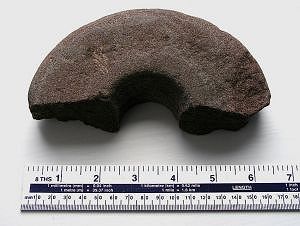Strathbrora Quern Stone
| The illustrated artifact is a broken upper rotary quern stone discovered in October 2003 in the Uarachoile area of Strathbrora - a landscape of former settlement going back to the prehistoric era. For many centuries, quern stones were used for corn-grinding and were generally much larger than this one. Grain was poured into the central hole or hopper and the quern rotated manually on a flat stone underneath it, typically by winding with a stick inserted in a hollow near the rim. This action ground down the corn and produced flour. |  | |
|
Stuart was especially struck by what he considered to be an especially small and quite rare example and explained that such stones are thought to have been used for preparing herbs or pigments rather than for grinding grain. The quern was subsequently passed on to Fraser Hunter, an Iron Age specialist, and his assessment was that it was from the Scottish Iron Age-approximately 600 BC to the middle of the first millennium AD. Similar miniature Iron Age querns have also been discovered in Angus and Fife. Interestingly, Ian Armit, an Inspector of Ancient Monuments with Historic Scotland, has thrown further light on their archaeological importance (Armit I. 1991), namely their contribution to structural dating sequences by way of what is known as the 'quern transition' or the 'quern replacement horizon', these indicating a technological shift from the earlier saddle querns to the rotary types around 200 BC. Additionally, these essentially domestic tools seem on occasion to have assumed symbolic significance and examples have been discovered in the walls or floors of round houses and in potentially transcendent or sacramental settings. It is worth recalling that Scotland interprets its archaeological 'treasure' to be all artifacts that might extend understanding of past cultures - not only precious materials but also the more common stuff made of stone, wood, bone, ceramics, glass and so forth. This is a more explicit application of the spirit and intention of UK law on what are known as portable antiquities. In practice, what it means for Scotland is that all ownerless finds - bona vacantia to use the still relevant Latin term - are, in the first instance, the property of the Crown (in effect the State) and should be declared when discovered. The quern was claimed as Treasure Trove by the Crown and in July this year and its finder received £30 for an item that will have its home in Inverness Museum. Members of NOSAS may be interested to know that the Crown Office has very recently decided to present finders with certificates acknowledging their contributions to cultural heritage and such a document - complete with the seal of the Queen's and Lord Treasurer's Remembrancer - is now in the possession of the present writer! Reference The website for the Advisory Panel is www.treasuretrove.org.uk
| ||